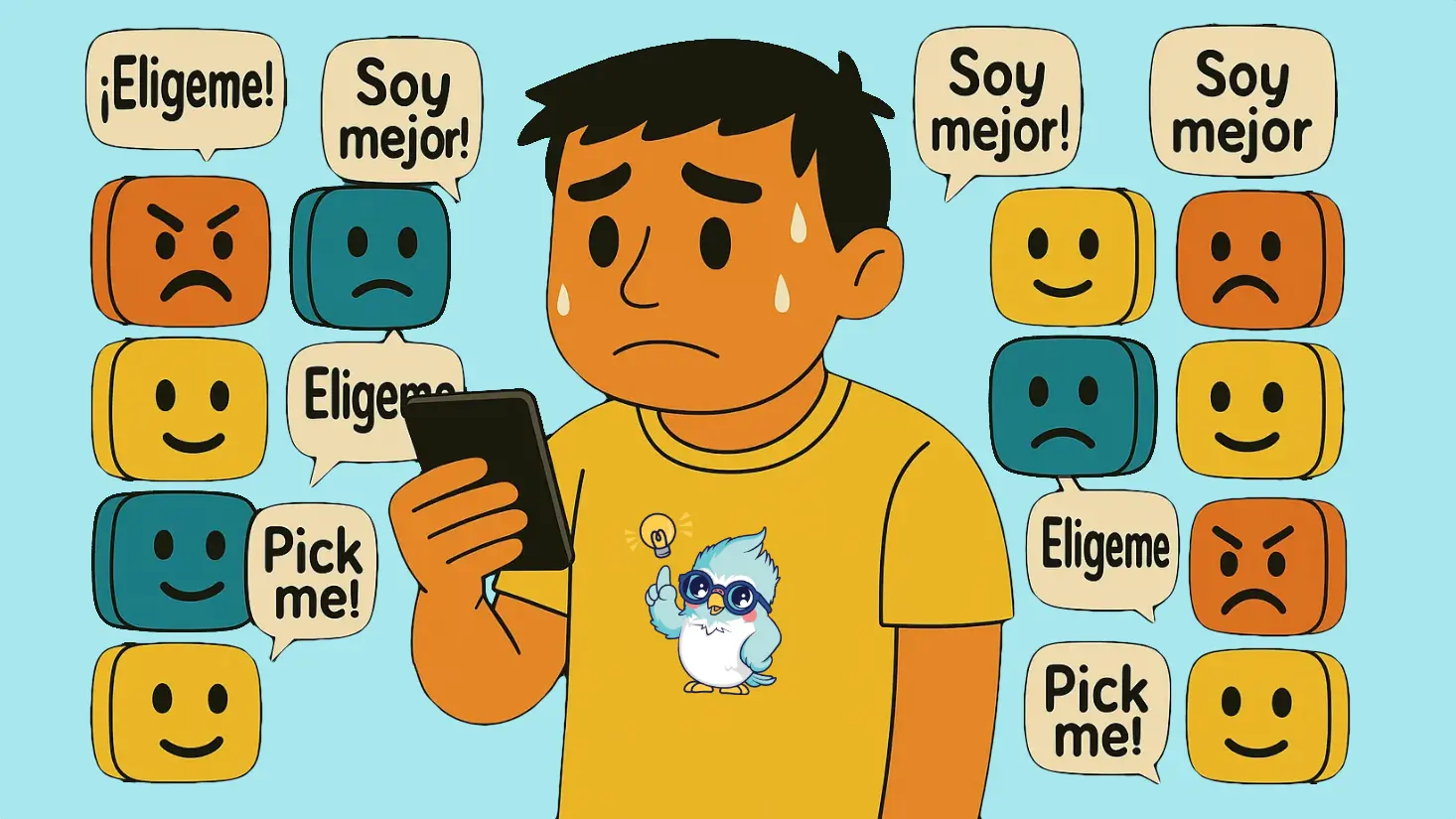The List of Best Spanish Learning Apps
Below is a table summarizing the Spanish learning apps highlighted by our research. It starts with lesser-known apps quickly gaining popularity, followed by the classic, well-established favorites.
| App Name | Price / Year | Languages | Primary Focus | Store Reviews | Pros (Reviews) | Cons (Reviews) |
|---|---|---|---|---|---|---|
Free, Premium $80/year | 10 | AI Tutor: Speaking & Pronunciation | iOS: 4.8⭐ | 🗣️ AI conversations 🎤 Human-like voices 📊 Progress tracking 🎭 Scenario-based | 🆓 No Android app yet | |
Free, Premium $120/year | 9 | Immersive Video-Based Learning | iOS: 4.7⭐ Android: 3.1⭐ | 🎞️ Real-world videos 🔤 Interactive subtitles 🧠 Vocab quizzes | 💲 Higher cost | |
Free, Pro $70/year | 50+ | Vocabulary in context | iOS: 4.8⭐ Android: 4.4⭐ | 🧩 Cloze tests 🔁 SRS 🎮 Gamified | 🧠 Not beginner-friendly | |
Free / iOS $25 one-time | Many | SRS flashcards | iOS: 4.1⭐ Android: 4.8⭐ | 🔁 Spaced repetition 🎛️ Highly customizable | ⏳ Steep learning curve | |
Free, Premium $10/month | Spanish | Immersion, Listening, Speaking | iOS: 4.6⭐ Android: 4.2⭐ | 🎧 Immersion audio 🧭 Active/Passive modes | 🎮 Less gamified | |
Free, Premium $80/year | 12+ | Structured lessons | iOS: 4.8⭐ Android: 4.5⭐ | 📘 Grammar notes 🔊 Native audio | 🗣️ Limited speaking practice | |
Free, Pro $8 | Spanish | Verb conjugation | iOS: 4.9⭐ Android: 4.7⭐ | 🧠 Verb drills 🎴 Mnemonics | 🎯 Narrow focus | |
Free, Premium $70/year | 14 | Social learning, CEFR | iOS: 4.7⭐ Android: 4.7⭐ | 🧭 CEFR-aligned 🗣️ Native feedback | 🎮 Less gamified | |
Paid only, $107/year | 14 | Practical conversation, Grammar | iOS: 4.7⭐ Android: 4.6⭐ | 🧑🏫 Expert-made lessons 🎤 Speech recognition | 💲 No permanent free tier | |
Free, Premium $60/year | 23+ | Vocabulary, Real-life conversation | iOS: 4.8⭐ Android: 4.7⭐ | 🎬 Native videos 🧠 Mnemonics | 📚 Less grammar depth | |
Free, Premium $80/year | 150+ | Practice with natives | iOS: 4.7⭐ Android: 3.6⭐ | 💬 Real conversations 🛠️ Built-in tools | 🔍 Partner matching needed | |
Free, Plus $84/year | 40+ | Comprehensive Spanish | iOS: 4.8⭐ Android: 4.7⭐ | 🎮 Gamified lessons 🔥 Streaks | 🗣️ Conversation depth limited |
What to Look for in a Spanish Learning App?
When searching for the best app to learn Spanish, prioritize platforms offering interactive learning paths that adapt to your proficiency level. The most effective Spanish learning apps incorporate spaced repetition systems for vocabulary retention and provide authentic native speaker audio to master proper pronunciation. Look for apps that offer interactive conversations with AI tutors that can correct your speaking in real-time, as these features dramatically accelerate your journey to fluency.
Beyond features, consider how the app structures its content. The best Spanish learning apps balance grammar instruction with practical conversation practice and cultural context. Before committing, check user reviews specifically mentioning progress tracking, content variety, and whether the app successfully keeps learners engaged beyond the first month. Remember that the best app to learn Spanish isn’t necessarily the most expensive one, but rather the one whose teaching approach aligns with your learning style and goals.
In-Depth Comparison of the Best Apps to Learn Spanish
1. Kippy AI
Kippy AI revolutionizes Spanish language learning through its innovative conversation-based approach that puts speaking practice at the forefront. Unlike traditional apps relying on repetitive drills, Kippy creates an immersive experience where learners engage in natural Spanish conversations with its friendly AI companion. The app’s sophisticated speech recognition technology provides instant feedback on pronunciation and grammar while maintaining a supportive environment that builds confidence in real-world Spanish speaking skills.
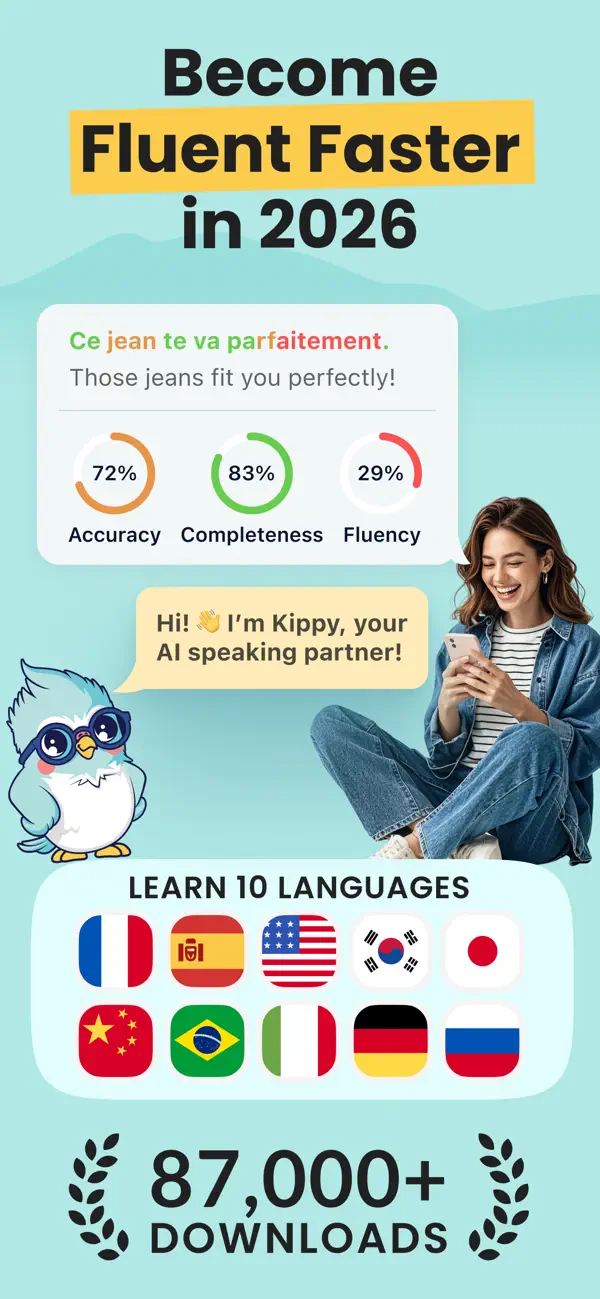
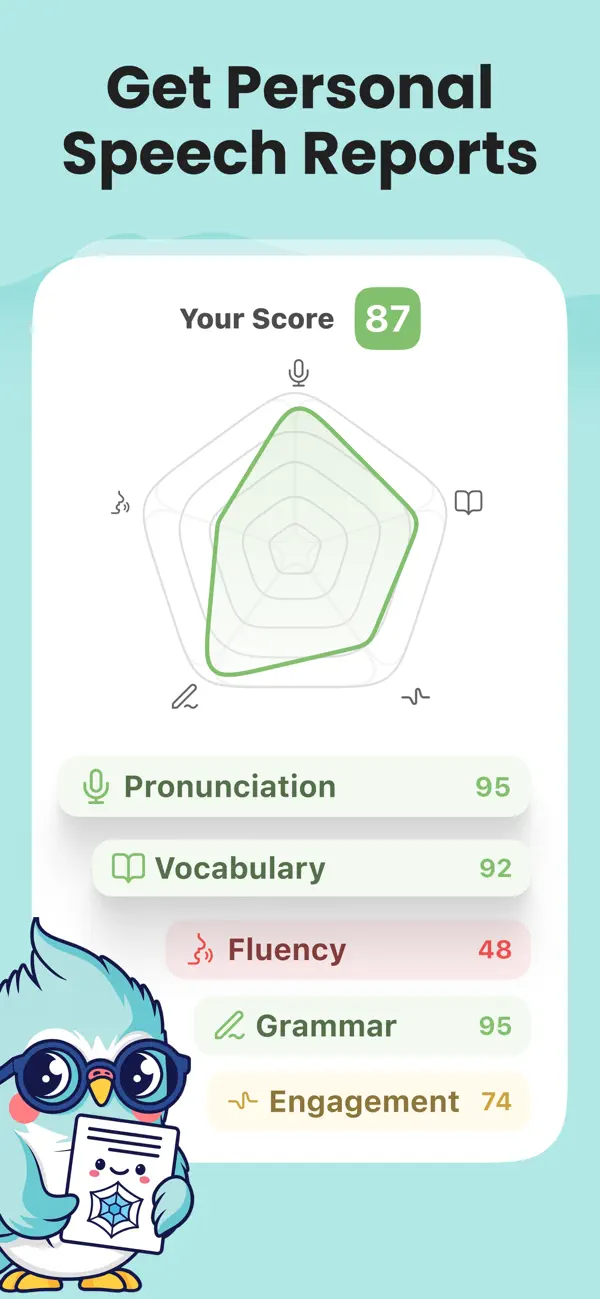
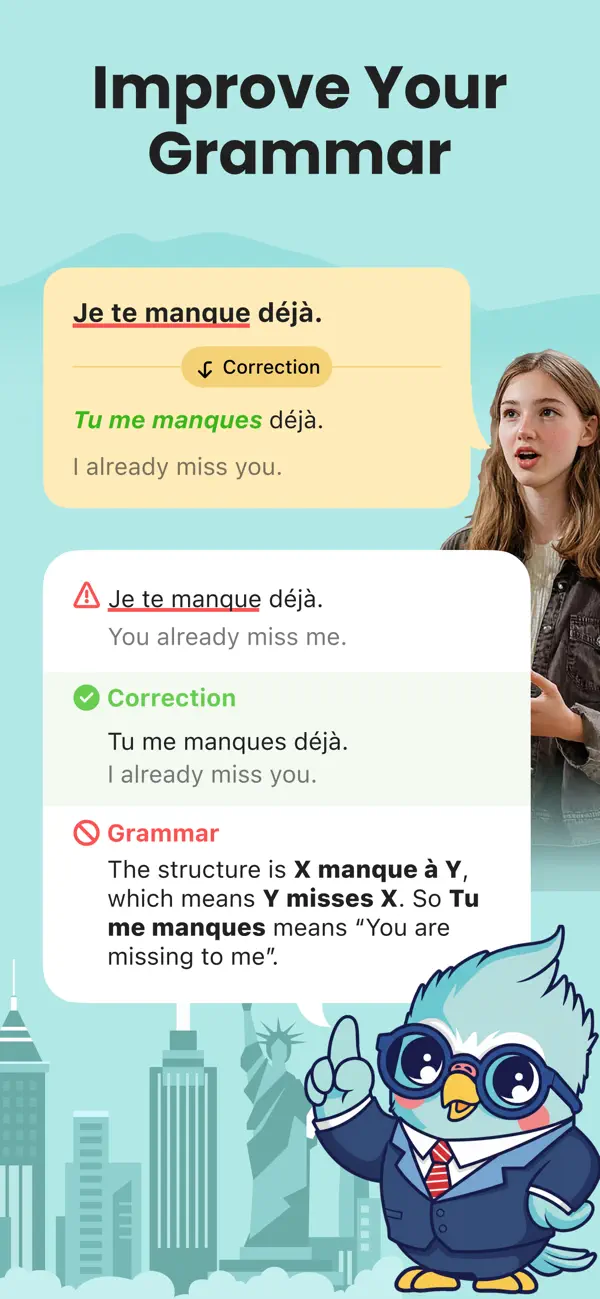
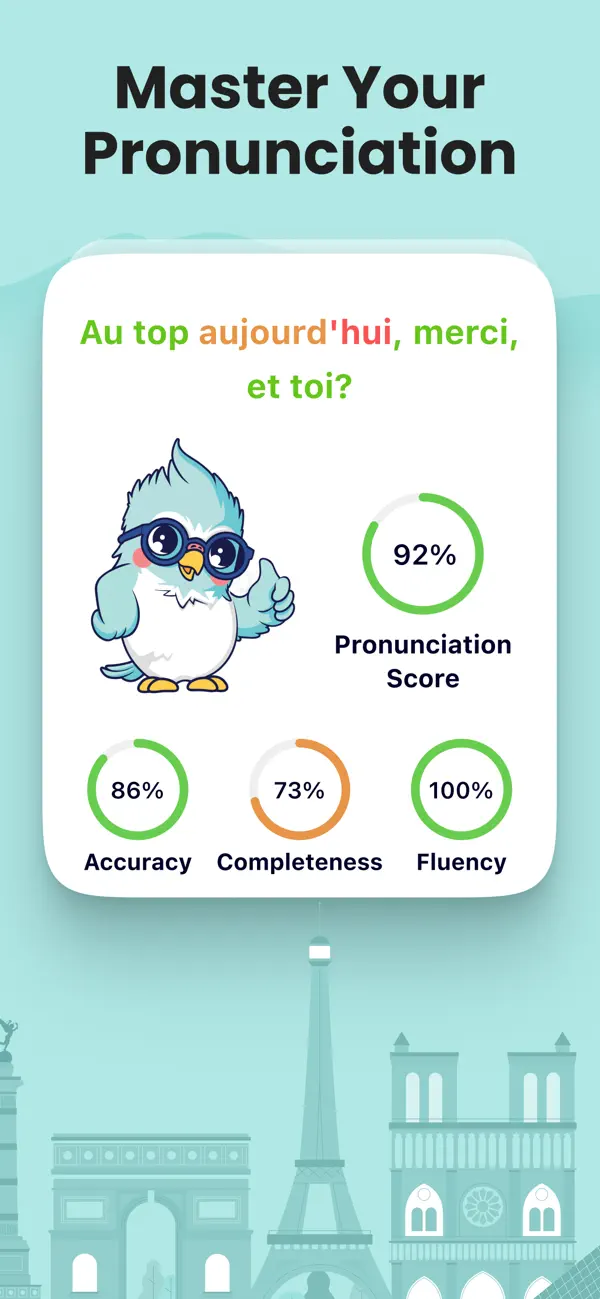
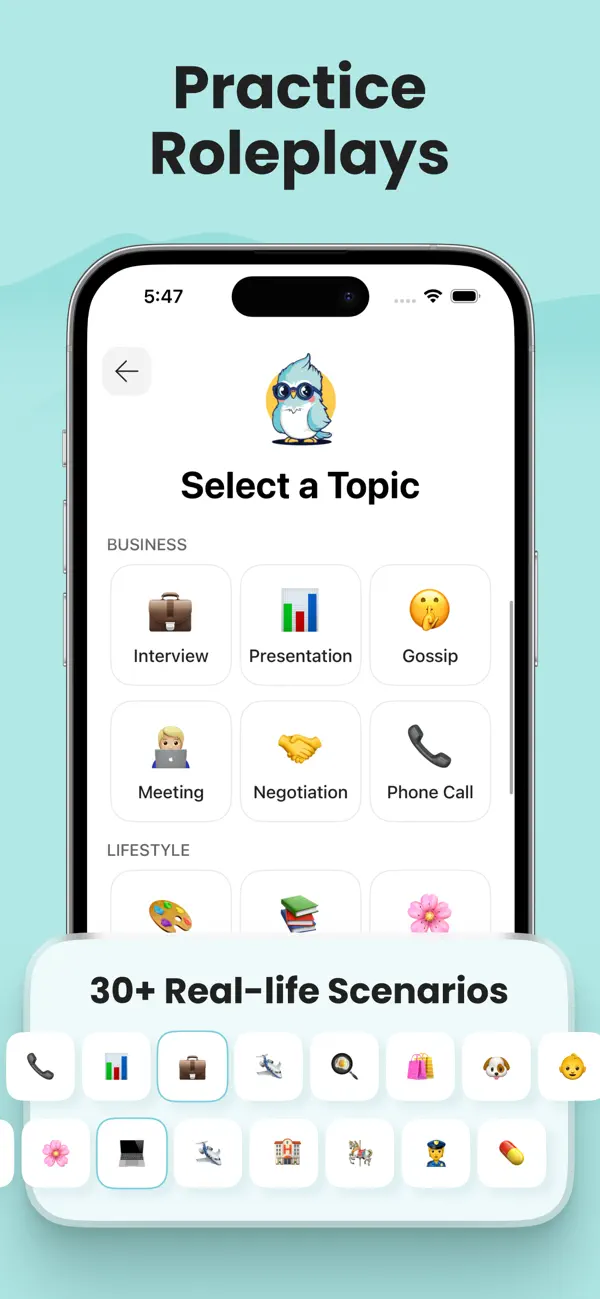
Download Kippy AI
📱 iPhone/iPad
How It Works
- Choose from 10 supported languages including English, Spanish, French, German, Korean, and others
- Simply tap the microphone button to begin conversing with Kippy
- Receive contextual responses with highlighted corrections and improvement suggestions
- Track your progress through the app’s analytics and vocabulary reports to see your learning progress over time
Pricing
Free tier: 10 minutes of conversation every day for free, forever. Premium: $79.99/year unlocks unlimited conversation practice and comprehensive correction tools.
Pros
- Intuitive, user-friendly interface with a gentle learning curve
- Comprehensive multi-language support within a single platform
- Real-time corrections include suggested translations and alternative phrasing options
- Adaptive AI remembers your common mistakes and tailors future conversations accordingly
Cons
- Not available on Android
- Some beginners may initially find the conversational approach challenging
2. FluentU
FluentU is an immersive language learning app that uses real-world videos to teach Spanish. It focuses on vocabulary and grammar, and it’s designed to help you understand how language is used in context. FluentU’s approach is based on the idea that the best way to learn a language is to see it in use. The app uses naturalistic videos to teach Spanish, and it includes interactive subtitles and quizzes to help you practice what you’ve learned. FluentU also offers personalized learning paths based on your level and interests.
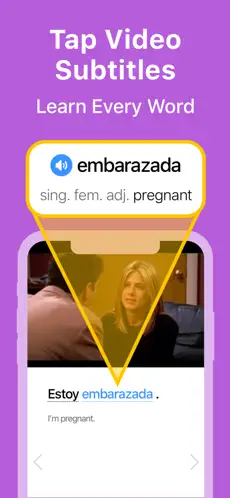
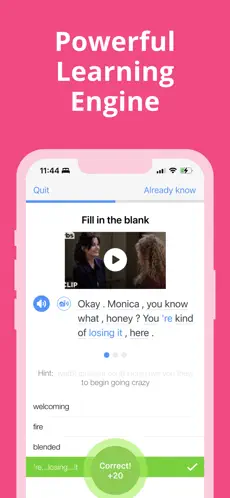

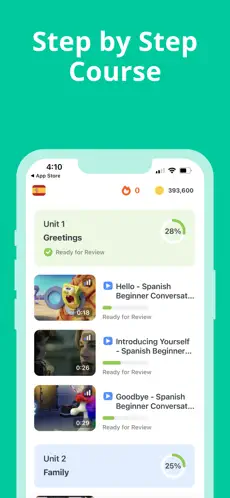
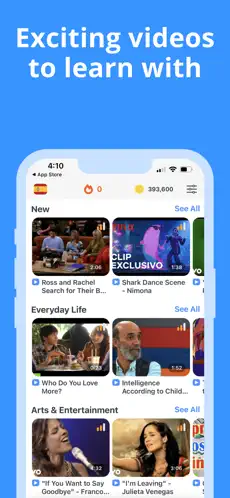
Download FluentU
📱 iPhone/iPad • 🤖 Android
How It Works
- Begin with a placement test to determine your Spanish proficiency level
- Follow structured 10-15 minute lessons organized by practical themes and situations
- Practice pronunciation through speech recognition technology
- Reinforce learning through personalized review sessions that appear at optimal intervals
Pricing
No free version beyond initial sample lessons. Subscription options: $14.95/month, $33.99/3 months, $83.99/year, or $199.99/lifetime access.
Pros
- Professionally developed curriculum created by language experts and native speakers
- Focus on practical, useful Spanish for everyday situations
- Excellent grammar explanations are integrated naturally within dialogue-based lessons
- Offline mode allows downloading lessons for learning without an internet connection
Cons
- Higher price point compared to some competitors with fewer free options
- Limited gamification features may reduce motivation for some learners
- Less extensive course depth for advanced Spanish learners
- Speech recognition occasionally struggles with certain accents or pronunciation variations
3. Clozemaster
Clozemaster offers a unique approach to vocabulary acquisition by using own tests, where learners fill in missing words in real-world sentences. This method emphasizes learning words in context, moving beyond single-word flashcards. Aimed at advanced beginners to intermediate learners (A2-C1 levels), the app is gamified, allowing users to score points and compete on leaderboards, and it supports over 50 languages. Clozemaster focuses on understanding language as it’s used in daily life by presenting sentences sorted by word frequency.
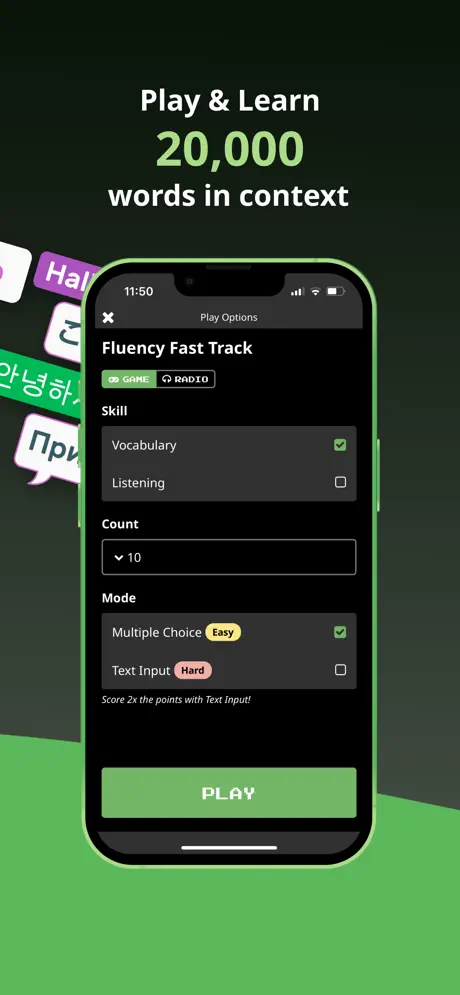

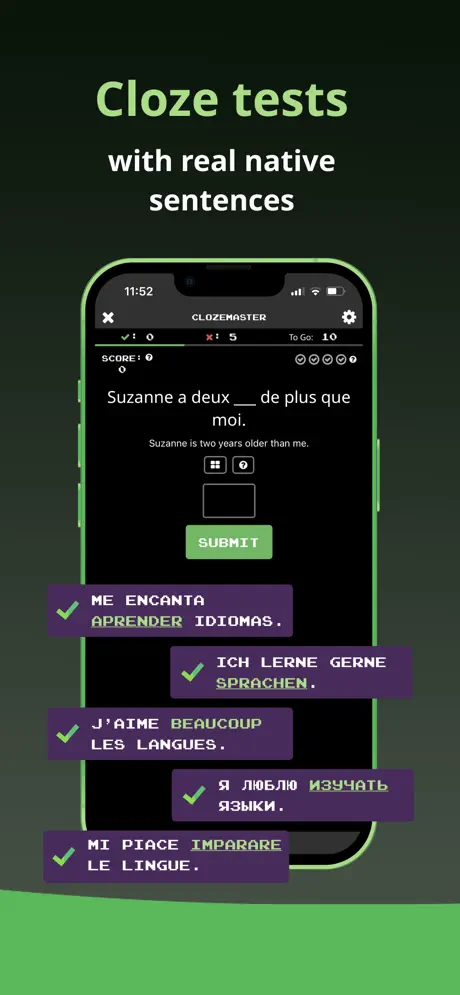
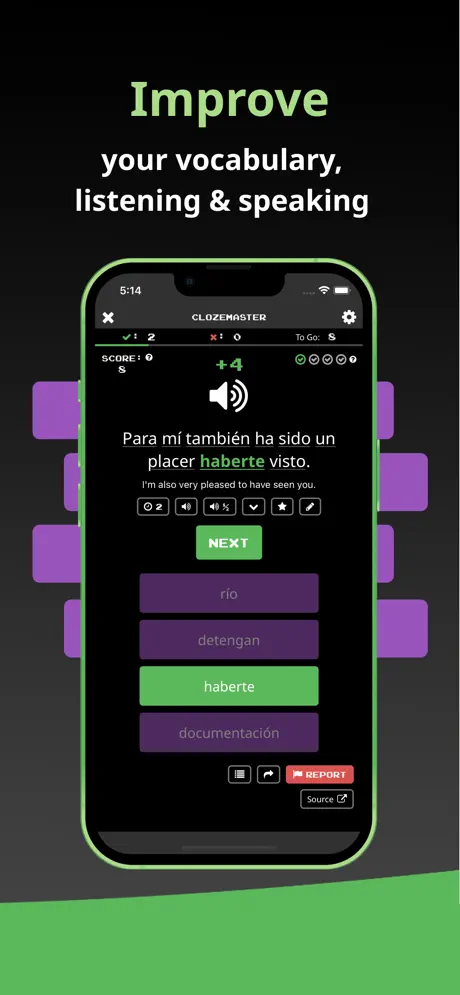
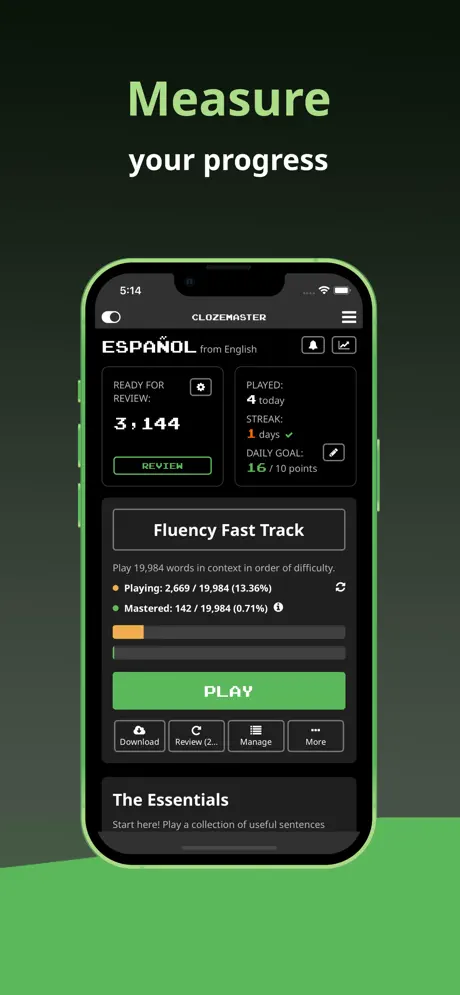
Download Clozemaster
📱 iPhone/iPad • 🤖 Android
How It Works
- Choose your target language and your native language to set up the learning pair.
- Engage in “cloze tests” by filling in the missing word in a sentence presented in your target language; a translation is provided for context.
- Opt for multiple-choice answers or type the answer directly for a greater challenge and more points.
- Progress through sentences often sorted by word frequency (e.g., in “Fluency Fast Track”) or focus on specific grammar points in “Grammar Challenges.”
- Review sessions show your score, rank, and mastery percentage, with options to revisit sentences and favorite important ones.
Pricing
Free version: Play through thousands of sentences, learn in context, and track basic progress. Clozemaster Pro (~$70/year): Unlimited access to all sentences and languages, advanced stats, offline mode, custom settings, and improved listening practice.
Pros
- Effective for vocabulary acquisition through contextual learning (cloze tests).
- Gamified elements (points, leaderboards) can enhance motivation.
- Utilizes Spaced Repetition System (SRS) for better long-term memory.
- Supports a very wide range of languages.
- Sentences, sometimes unusual, can be highly memorable.
- Good mobile apps with offline access for Pro users.
- Robust free version offers significant value.
Cons
- User interface can be perceived as cluttered or dated.
- Less suitable for absolute beginners; a basic understanding of the language is beneficial.
- Lacks in-depth, explicit grammar instruction.
- Typing answers might feel cumbersome, particularly on mobile.
- Primarily a supplementary tool, not a complete language course.
4. Anki
Anki is a powerful, open-source flashcard program renowned for its use of spaced repetition system (SRS) algorithms to enhance long-term memory retention. Users can create their own digital flashcards with text, images, audio, and even scientific markup, or download from a vast library of pre-made decks. Anki is highly customizable, allowing users to tailor card layouts and review timings. It’s designed to help learners spend more time on challenging material and less on what’s already known, making it a popular tool for students, particularly in fields like medicine and language learning.
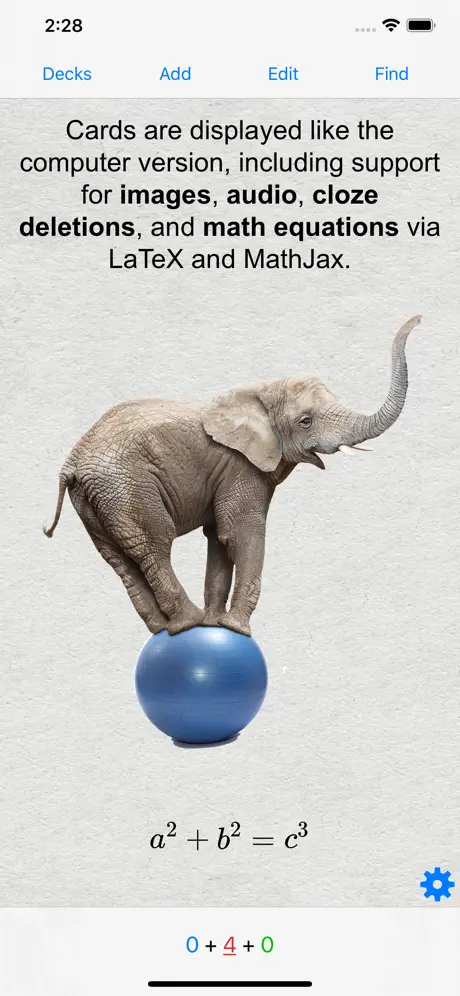
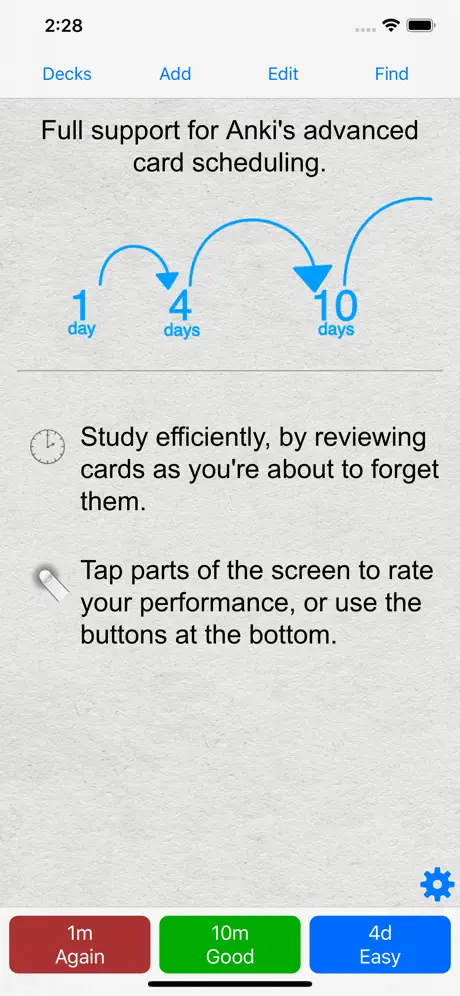
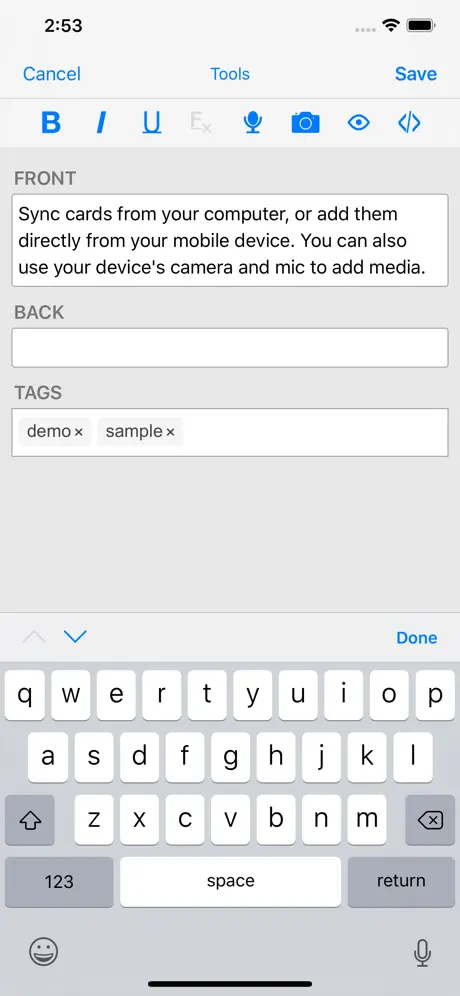
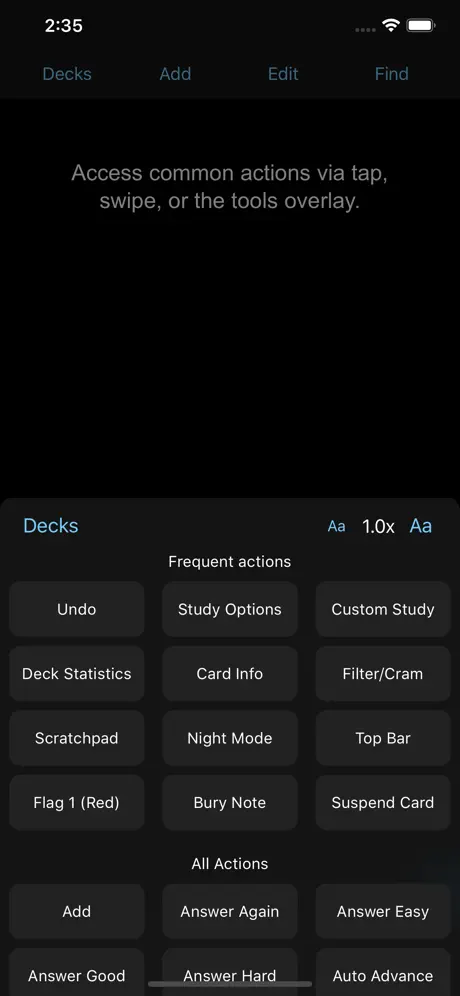
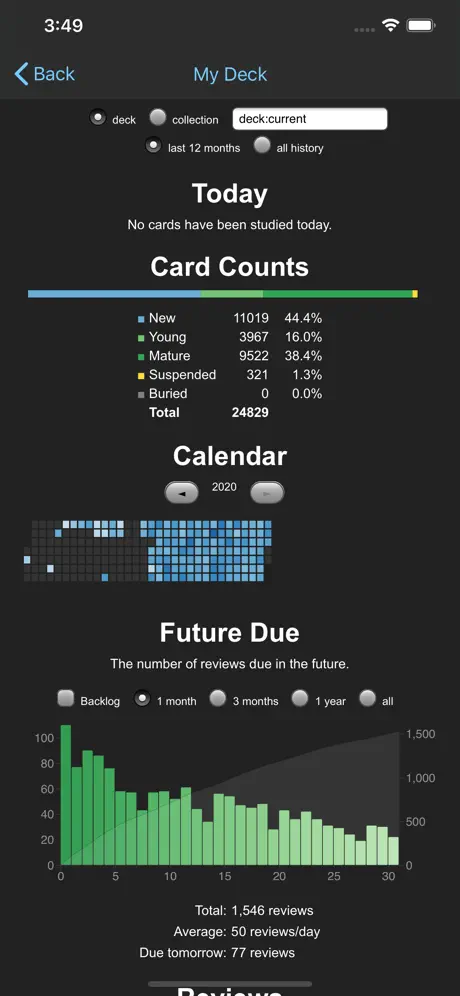
Download Anki
📱 iPhone/iPad • 🤖 Android
How It Works
- Create digital flashcards with a “Front” (question/prompt) and a “Back” (answer/information). You can include text, images, and audio.
- Organize cards into “Decks” (e.g., by subject) and optionally add “Tags” for more granular organization or custom study sessions.
- Review cards daily. Anki shows you the front; you recall the answer, then reveal it.
- Rate your recall difficulty (“Again,” “Hard,” “Good,” “Easy”). Anki’s spaced repetition algorithm schedules the next review based on this, showing harder cards sooner and easier cards later.
- Sync your decks across devices (computer, smartphone) via AnkiWeb to study anywhere.
Pricing
AnkiDroid (Android): Free and open-source. AnkiMobile (iOS): $24.99 (one-time purchase for the official iOS app, supports overall Anki development).
Pros
- Highly effective Spaced Repetition System (SRS) for long-term memorization.
- Extremely customizable cards (text, images, audio, video, LaTeX) and review settings.
- Vast library of user-created add-ons to extend functionality (e.g., image occlusion).
- Large collection of pre-made decks for various subjects, including Spanish.
- Cross-platform availability with cloud sync (AnkiWeb).
- Supports offline study on desktop and mobile apps.
- Free and open-source on desktop and Android.
Cons
- Steep learning curve; can be initially complex to set up and use effectively.
- Requires consistent daily reviews for SRS to be optimal; can lead to card backlog.
- Creating high-quality, atomized flashcards can be very time-consuming.
- Primarily focuses on memorization; may not inherently build contextual understanding or conversational skills.
- The official iOS app (AnkiMobile) is a paid one-time purchase.
- Default user interface is functional but not as polished as some other apps.
5. Camino
Camino Spanish, by Curiosity Media (the makers of StudySpanish.com), emphasizes an immersion-based learning method. It aims to leverage the brain’s natural ability to acquire language by immersing learners in Spanish in a relaxed, self-paced environment. The app features high-quality audio with native speakers and follows a narrative of an American’s journey in a Latin American country, introducing vocabulary and grammar through dialogues and drills related to real-life situations. It supports both active (visual and audio) and passive (audio-only) learning modes, and includes optional grammar lessons, tests, and interactive flashcards.
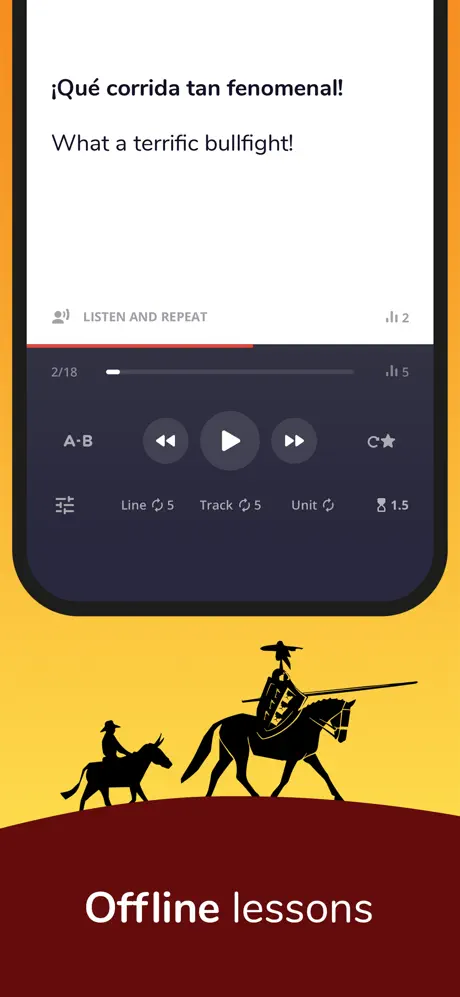
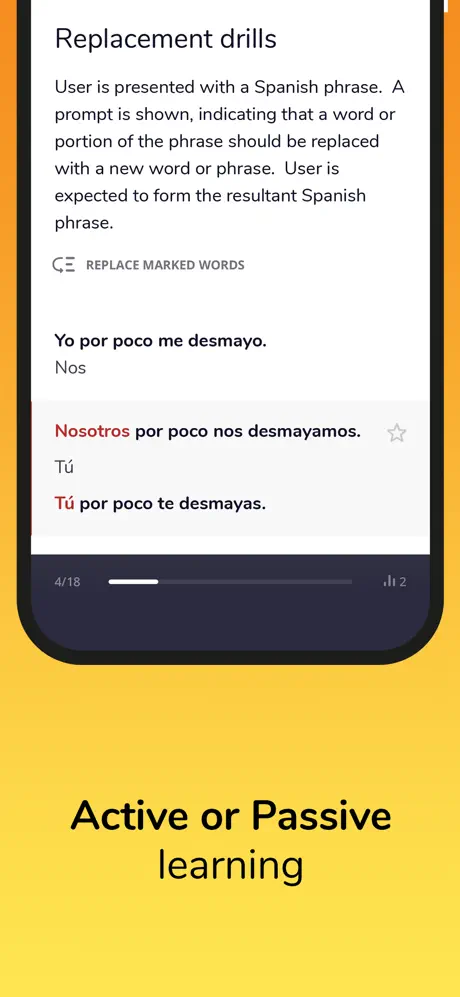
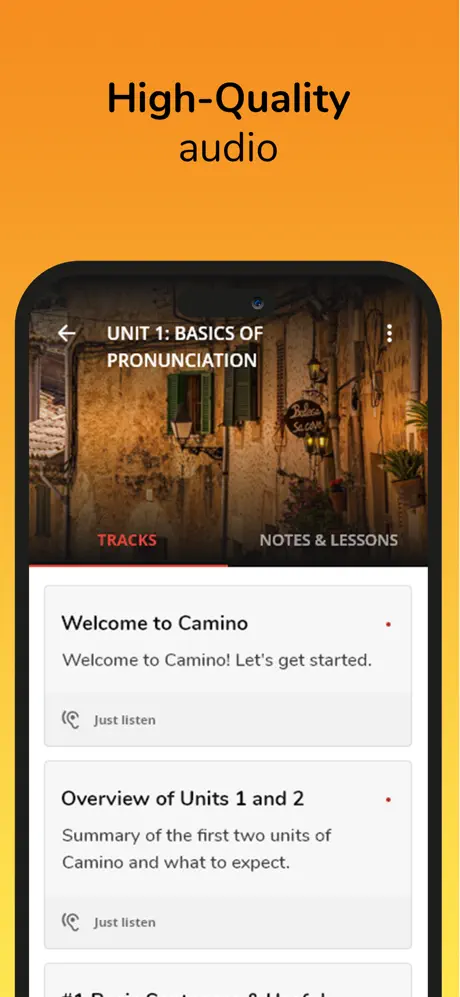

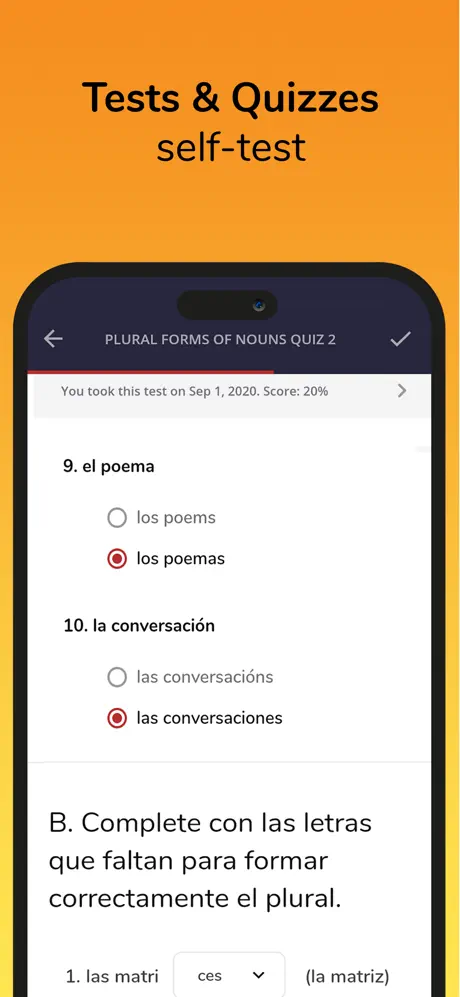
Download Camino
📱 iPhone/iPad • 🤖 Android
How It Works
- Begin by listening to and imitating authentic Spanish speech to build a comfort level with pronunciation.
- Follow a narrative story about an American (“John White”) moving to a Latin American country, learning vocabulary and grammar through dialogues related to his experiences.
- Engage in lessons and drills that reinforce the Spanish learned from the dialogues.
- Choose between “Active” mode (visuals and audio) or “Passive” mode (audio-only for learning while multitasking).
- Optionally, access supplementary grammar lessons, tests, and interactive flashcards to deepen understanding of specific topics.
Pricing
Free Membership: Access to many lessons, limited tests/quizzes, and some Camino app features. Premium Monthly ($9.99/month): Full access to StudySpanish.com resources, all Camino app features, audio podcasts, and progress tracking (often includes a free trial period). Premium Lifetime ($119.99 one-time): All Premium features with a single lifetime payment.
Pros
- Effective immersion-based learning through a narrative storyline and dialogues.
- High-quality, clear audio from native Spanish speakers enhances pronunciation.
- Flexible learning with Active (visual & audio) and Passive (audio-only) modes.
- Customizable playback settings (pauses, repetition) to suit individual learning pace.
- Includes interactive flashcards and quizzes for vocabulary reinforcement.
- Offers supplementary grammar lessons and tests for deeper understanding.
- Downloadable lessons for convenient offline study.
Cons
- The immersion approach might be initially challenging for absolute beginners without prior grammar knowledge.
- Less gamified compared to other apps, which may affect motivation for some users.
- Content is primarily geared towards beginner to intermediate levels; advanced learners may seek more.
- Effectiveness is highly dependent on the learner’s discipline and consistent engagement.
- The associated StudySpanish.com website interface can be confusing to navigate.
6. LingoDeer
LingoDeer offers structured, curricula-based courses for learning languages, with a particular strength in Asian languages like Japanese, Korean, and Chinese, but also including Spanish, French, German, and others. The app focuses on providing clear explanations of grammar and enabling users to form sentences, moving from beginner to intermediate (A1-B1) levels. It features HD audio recordings by native speakers to aid pronunciation, various review activities like flashcards and quizzes, and allows for offline learning.
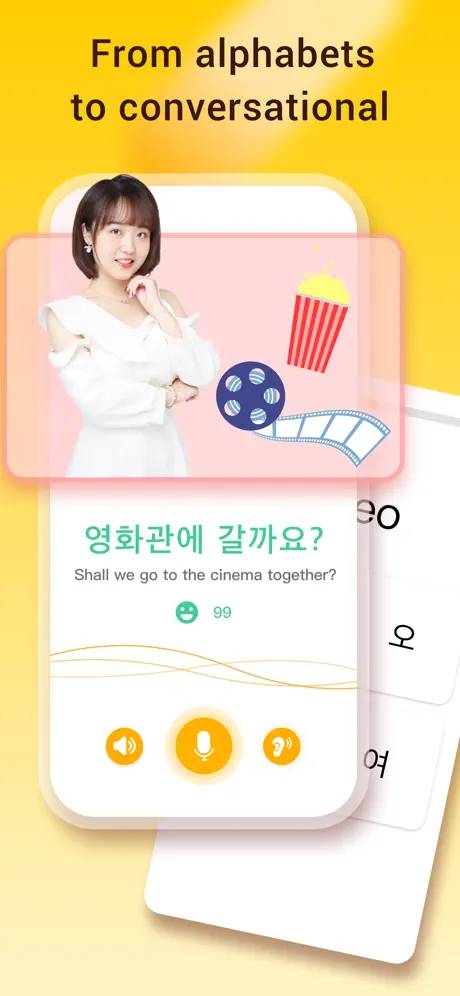
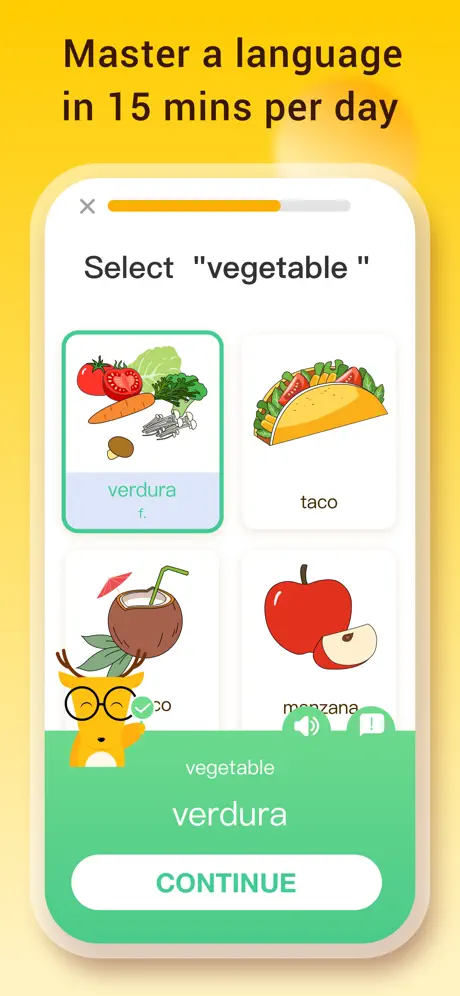
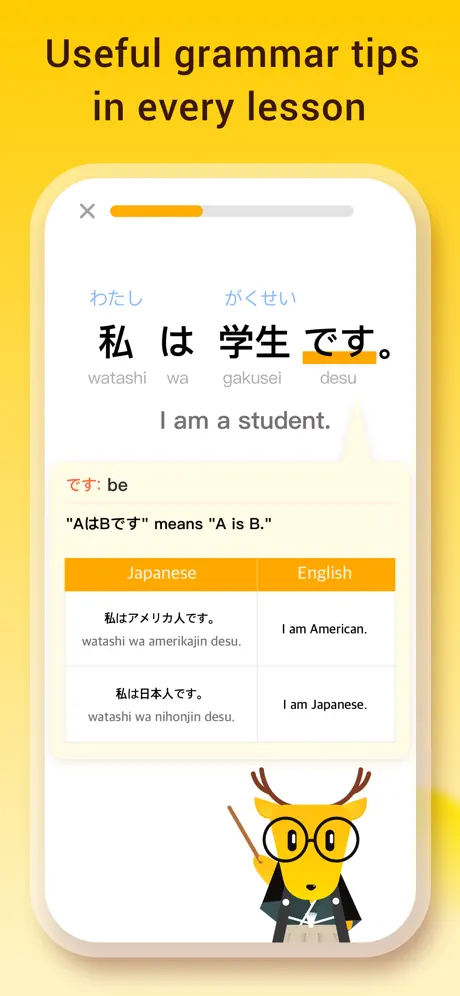
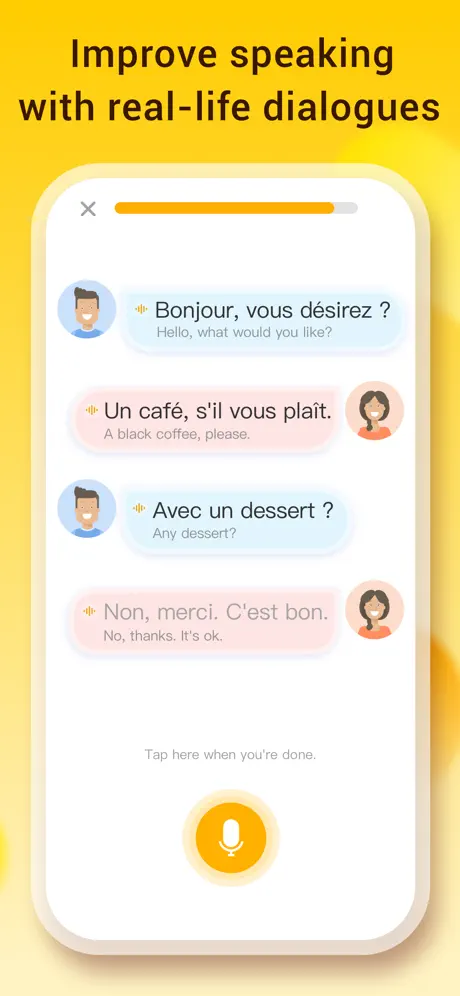
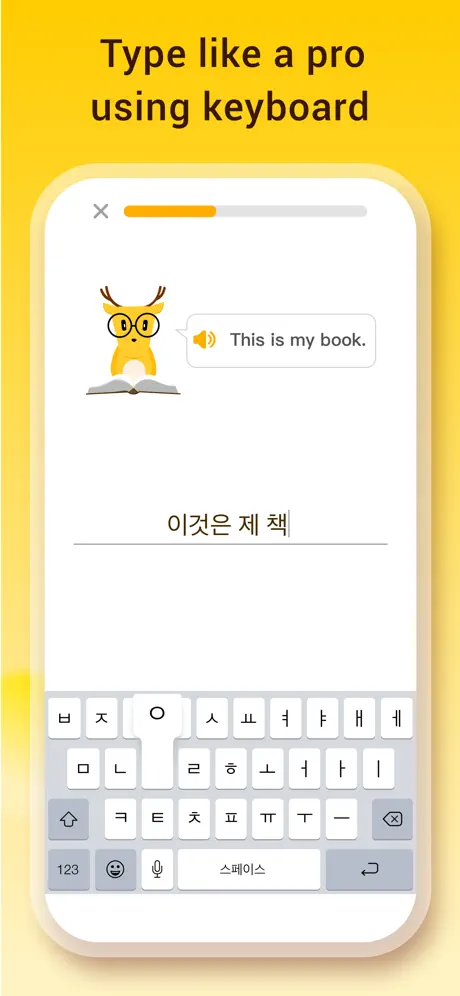
Download LingoDeer
📱 iPhone/iPad • 🤖 Android
How It Works
- Select your target language (e.g., Spanish) and navigate through a structured lesson tree.
- Each lesson unit typically includes “Learning Tips” (grammar explanations), “Stories” (dialogues/texts using new concepts), and “Lesson Activities” (interactive exercises).
- Work through activities like matching, fill-in-the-blanks, sentence building, and listening comprehension, often with native speaker audio.
- Some lessons include character writing practice (for relevant languages) and speaking exercises with voice recognition.
- Review learned material through flashcards, quizzes, and spaced repetition features to reinforce vocabulary and grammar.
Pricing
Free version: Limited access to introductory lessons and features in the main LingoDeer app. LingoDeer Premium (~$80/year): Full access to all structured courses, grammar notes, offline mode, and other features in the main LingoDeer app. LingoDeer Lifetime: One-time payment (price varies, often discounted during sales, e.g., ~$120-$300) for lifetime access to all LingoDeer content and features; bundles with LingoDeer Plus (game app) may also be available.
Pros
- Well-structured Spanish lessons with clear and comprehensive grammar explanations, excellent for beginners.
- High-quality HD audio by native Spanish speakers significantly aids pronunciation learning.
- Offers distinct learning paths for Castilian (Spain) and Latin American Spanish.
- Good variety of interactive exercises (fill-in-the-blanks, matching, listening comprehension) to practice different skills.
- Offline mode allows for convenient learning on the go without an internet connection.
- Visually appealing and user-friendly interface with customizable settings.
- Includes a useful free travel phrasebook.
Cons
- Spanish course content may lack depth for advanced learners (B2 and above).
- Limited opportunities for actual speaking practice and real-time conversation feedback.
- Lacks authentic video content or exposure to unscripted, natural language.
- Progression can feel restrictive as users must pass “Test Out” quizzes to unlock later lessons.
- Some features may be less developed for Spanish compared to its core Asian language courses.
7. ConjuGato
ConjuGato is a focused Spanish language learning app designed to help users master verb conjugations, often considered one of the trickiest aspects of the language. It offers flexible practice modes, allowing users to customize exercises by verb irregularity, endings, or popularity. The app includes conjugation tables, mnemonic flashcards for remembering similar verbs, and audio pronunciation, all aimed at making grammar practice efficient and enjoyable, even offline.
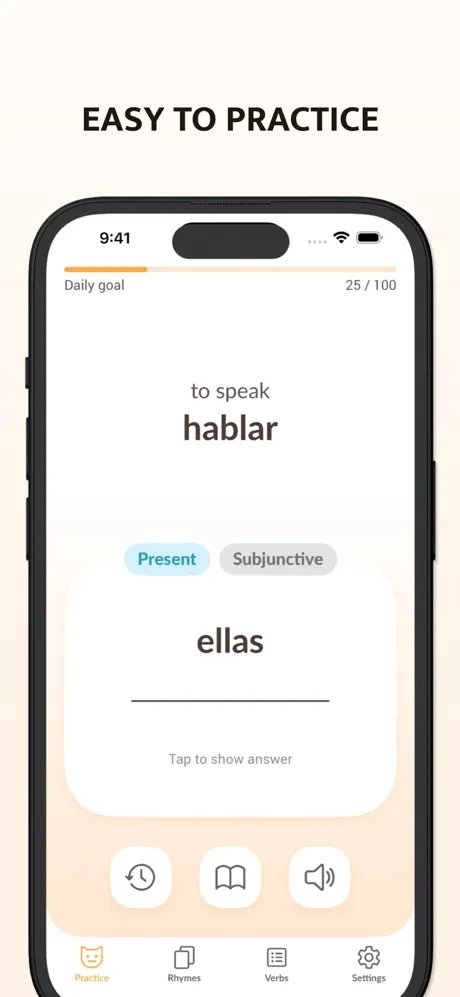
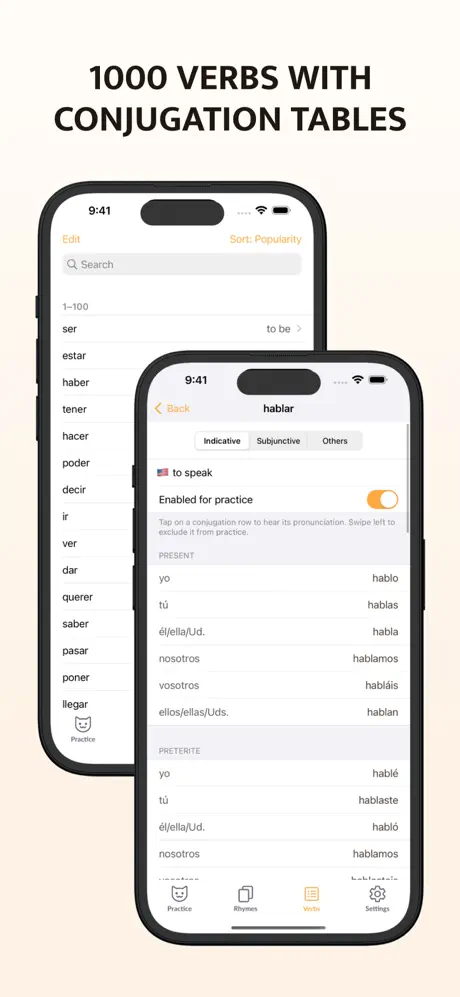


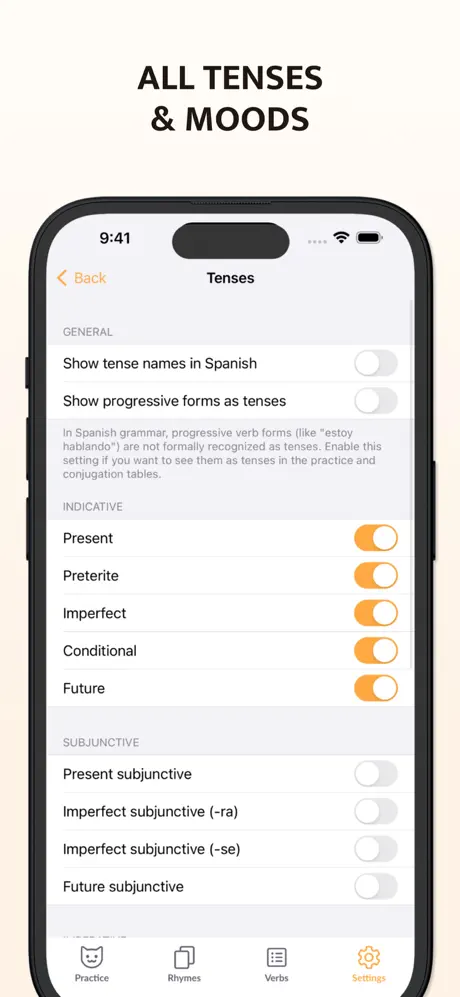
Download ConjuGato
📱 iPhone/iPad • 🤖 Android
How It Works
- Select verb tenses and moods (Indicative, Subjunctive, Imperative) you want to practice.
- Customize practice by verb irregularity, common endings, or overall popularity.
- Practice conjugations by thinking or saying the correct form, then tap to reveal and check.
- Utilize mnemonic flashcards that group similar-sounding verbs to aid memory.
- Refer to full conjugation tables for each verb, with irregular forms highlighted.
Pricing
Free version: Access to 250 verbs, 27 flashcards, Indicative mood, Present & Preterite tenses, and Present progressive forms. Pro Version (one-time purchase ~$7.99): Unlocks 1000 verbs, 104 flashcards, all moods, and all tenses.
Pros
- Excellent for mastering Spanish verb conjugations, a core skill for fluency.
- Highly customizable practice (tenses, moods, verb types) caters to both beginner and advanced learners.
- Includes helpful tools like full conjugation tables and mnemonic flashcards.
- Supports offline practice and an affordable one-time Pro unlock (no subscriptions).
- Option to disable ‘vosotros’ makes it suitable for both Peninsular and Latin American Spanish learners.
Cons
- Narrow focus: Only covers verb conjugations, not a comprehensive language learning app.
- Self-assessment model for practice might not suit learners who prefer typed input and direct correction.
- Lacks broader contextual learning (e.g., full sentence examples, dialogues).
- Primarily a solo study tool, no peer-to-peer interaction.
- Might be overwhelming for absolute beginners unfamiliar with basic grammar concepts.
8. Busuu
Busuu offers a structured Spanish learning program enhanced by direct feedback from native speakers in its global language community. The platform combines expert-designed lessons covering reading, writing, speaking, and listening with the opportunity to have your practice exercises corrected by native Spanish speakers. Busuu’s comprehensive curriculum follows the Common European Framework of Reference (CEFR) levels, providing clear progression from beginner (A1) to upper intermediate (B2) Spanish proficiency.
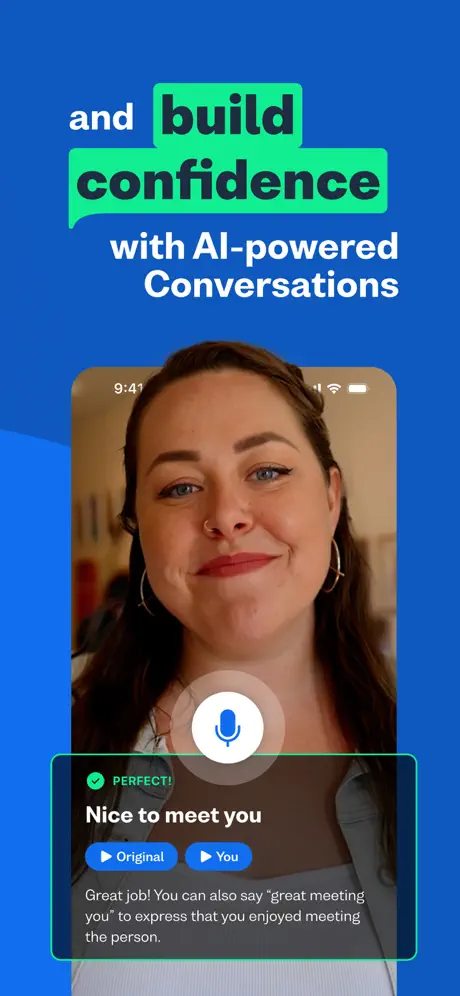

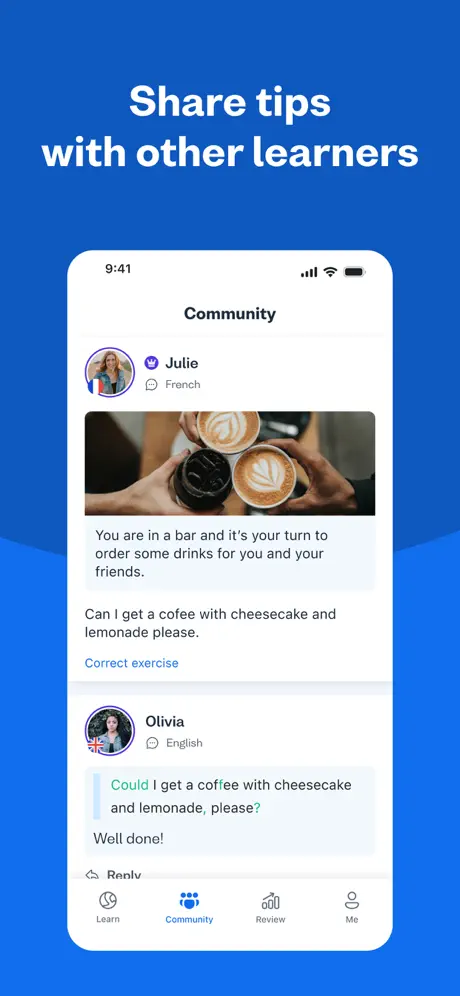


Download Busuu
📱 iPhone/iPad • 🤖 Android
How It Works
- Complete structured lessons combining vocabulary, grammar, and comprehension exercises
- Submit writing and speaking exercises for correction by native Spanish speakers
- Practice with dialogue scenarios, preparing you for real-world conversations
- Create a personalized study plan based on your goals and available study time
Pricing
Free tier: Basic lessons with limited features. Premium: $9.99/month or $89.99/year for full course access. Premium Plus: $13.99/month or $119.99/year, adding certification and personalized study plans.
Pros
- Structured curriculum aligned with internationally recognized CEFR standards
- Feedback from actual native Spanish speakers on pronunciation and writing
- Offline mode allows downloading lessons for learning anywhere
- Personalized study plans that adapt to individual goals and schedules
Cons
- Community corrections sometimes vary in quality and detail
- Limited free content compared to the premium offering
- Some users report occasional technical issues with the speech recognition feature
- Less gamification than competitors like Duolingo
9. Babbel
Babbel delivers a comprehensive Spanish learning experience focused on practical, conversation-based lessons designed by language experts. The platform emphasizes teaching Spanish you’ll actually use, with content tailored to real-life situations like ordering food, asking for directions, or having business conversations. Babbel’s speech recognition technology provides immediate pronunciation feedback, and the app’s review sessions use spaced repetition to optimize vocabulary retention.

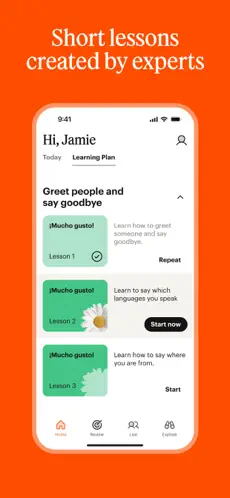
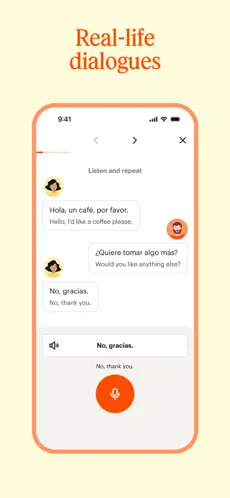
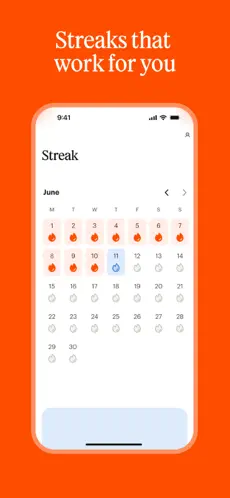
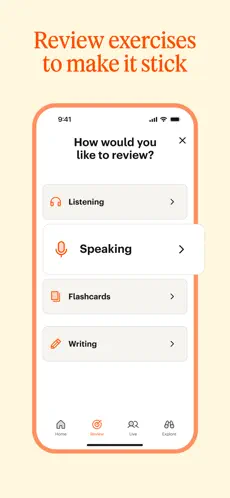
Download Babbel
📱 iPhone/iPad • 🤖 Android
How It Works
- Begin with a placement test to determine your Spanish proficiency level
- Follow structured 10-15 minute lessons organized by practical themes and situations
- Practice pronunciation through speech recognition technology
- Reinforce learning through personalized review sessions that appear at optimal intervals
Pricing
No free version beyond initial sample lessons. Subscription options: $14.95/month, $33.99/3 months, $83.99/year, or $199.99/lifetime access.
Pros
- Professionally developed curriculum created by language experts and native speakers
- Focus on practical, useful Spanish for everyday situations
- Excellent grammar explanations are integrated naturally within dialogue-based lessons
- Offline mode allows downloading lessons for learning without an internet connection
Cons
- Higher price point compared to some competitors with fewer free options
- Limited gamification features may reduce motivation for some learners
- Less extensive course depth for advanced Spanish learners
- Speech recognition occasionally struggles with certain accents or pronunciation variations
10. Memrise
Memrise stands out with its unique approach to Spanish vocabulary acquisition through memorable, often humorous video clips featuring native speakers in authentic settings. The app leverages spaced repetition science while incorporating “mems” (mnemonic devices) to make vocabulary stick. Memrise’s emphasis on learning Spanish as it’s actually spoken—with regional variations, slang, and natural speech patterns—gives learners exposure to authentic language beyond textbook Spanish.


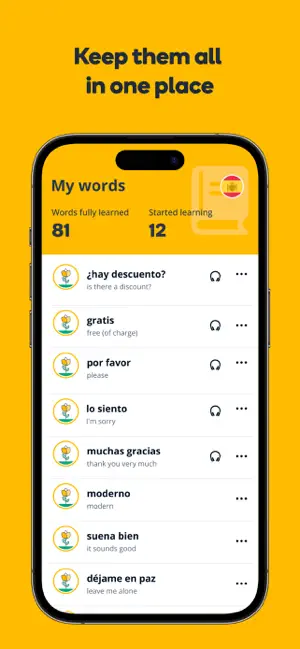


Download Memrise
📱 iPhone/iPad • 🤖 Android
How It Works
- Learn through short video clips of native Spanish speakers in everyday settings
- Use spaced repetition flashcards enhanced with visual and memory aids
- Practice with multiple-choice, typing, and listening exercises
- Progress through difficulty levels from beginner phrases to advanced conversation
Pricing
Free tier: Limited access to courses and features Premium: $8.99/month, $90/year, or $139.99/lifetime, unlocking all content and features
Pros
- Exposure to authentic, native Spanish from various regions and dialects
- Visual learning approach with real Spanish speakers in context
- Effective memory techniques help vocabulary retention
- Community-created courses supplement official content for specialized vocabulary
Cons
- Less structured grammar instruction than some competitors
- Mobile app offers better experience than web version
- Official courses sometimes lack depth for advanced learners
- Free version quite limited compared to premium offering
11. HelloTalk
HelloTalk revolutionizes language learning by connecting you directly with native Spanish speakers worldwide through its language exchange community. Rather than following structured lessons, HelloTalk facilitates authentic conversations with over 30 million global users through text, voice messages, calls, and video chats. The app’s built-in translation tools, pronunciation corrections, and word banks support natural language acquisition through real human interaction.
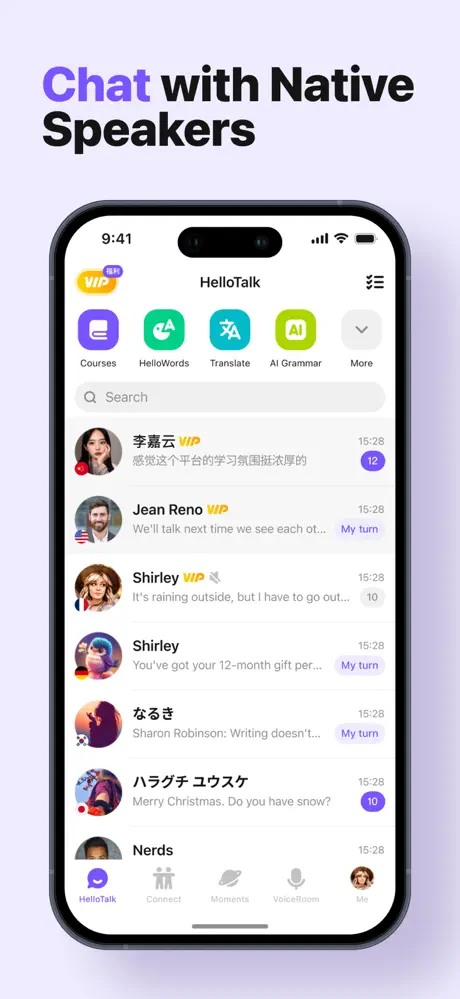
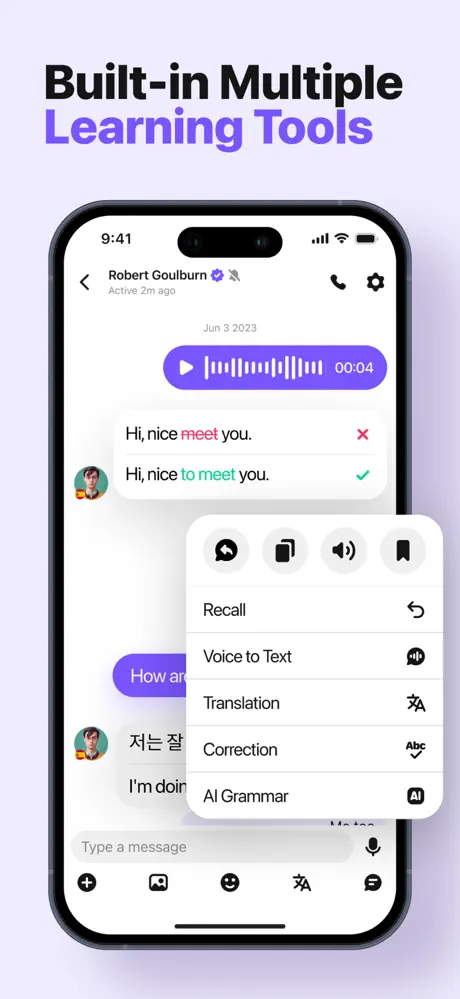
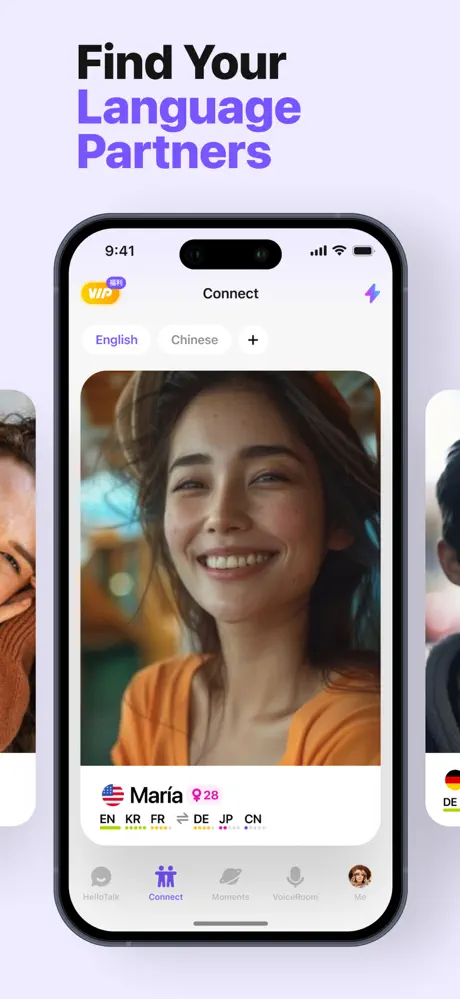
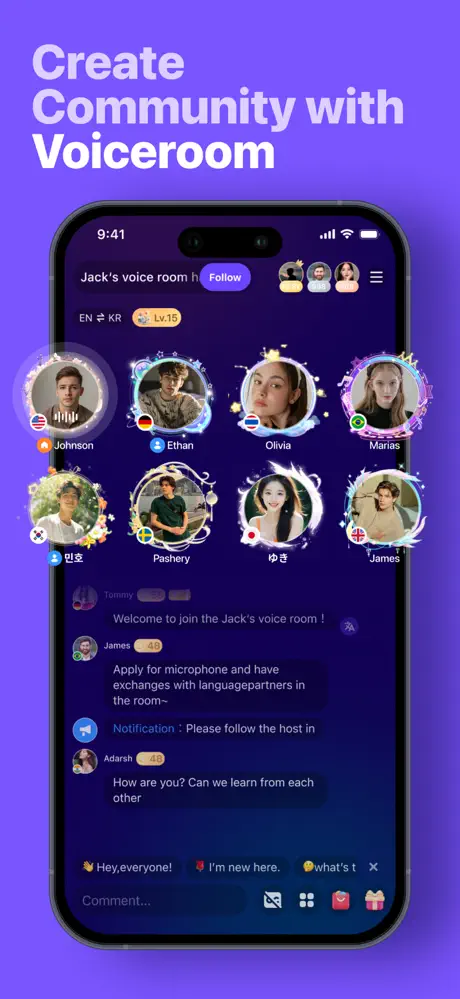
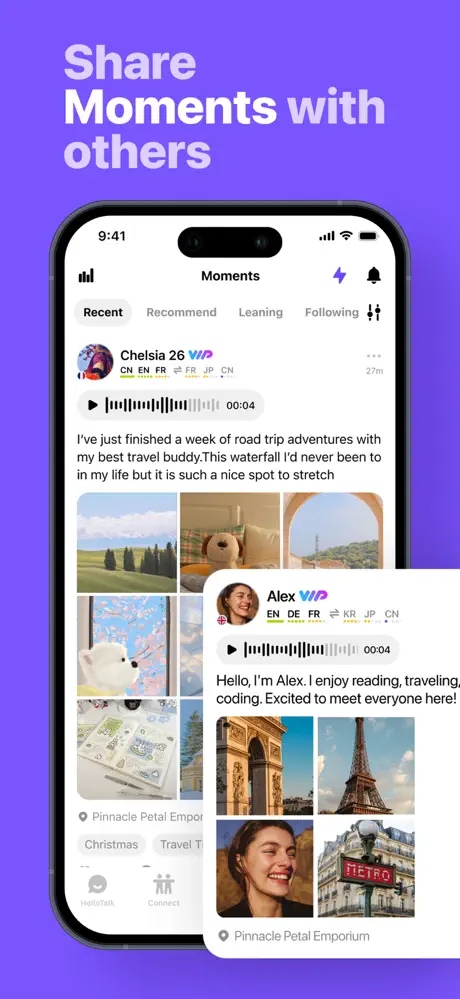
Download HelloTalk
📱 iPhone/iPad • 🤖 Android
How It Works
- Create a profile specifying Spanish as your target language and your native language as what you can offer
- Connect with native Spanish speakers interested in learning your language
- Use integrated translation, correction, and voice-to-text tools during conversations
- Join “Moments” (social posts) to engage with the broader community and practice writing skills
Pricing
Free tier: Basic language exchange features with limited translation capabilities. VIP membership: $6.99/month or $49.99/year removes ads and unlocks advanced features like language courses.
Pros
- Authentic conversation practice with native Spanish speakers builds real-world fluency
- Cultural immersion alongside language learning through genuine connections
- Flexible learning schedule based on your availability and conversation partners
- Built-in correction tools help improve grammar and pronunciation in context
Cons
- Learning progress depends heavily on finding compatible language partners
- Less structured approach may not suit beginners needing foundational instruction
- Some users report receiving unwanted romantic advances despite the app’s language-learning focus
- Requires regular time commitment to maintain active language exchange relationships
12. Duolingo
Duolingo Max elevates the popular language learning platform with advanced AI capabilities that transform how you master Spanish. This premium version integrates OpenAI’s GPT-4 technology to create personalized learning experiences that adapt to your specific strengths and weaknesses. Beyond the app’s signature gamified lessons, Max subscribers enjoy AI-powered roleplay conversations with beloved Duolingo characters and receive detailed explanations that clarify complex Spanish grammar concepts exactly when you need them most.

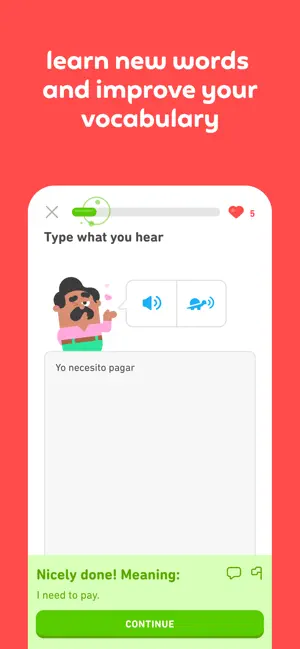
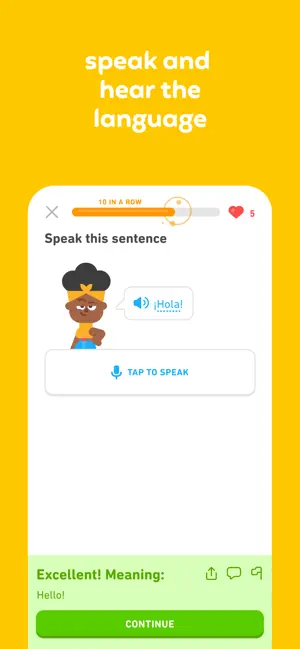
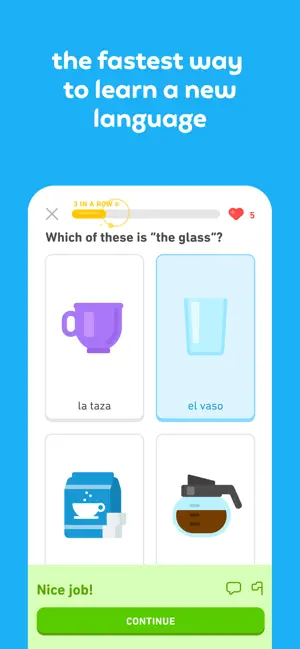

Download Duolingo
📱 iPhone/iPad • 🤖 Android
How It Works
- Select Spanish from over 40 available languages
- Complete bite-sized lessons ranging from 2–5 minutes each
- Engage in AI Roleplay scenarios to practice contextual dialogues with feedback on errors (Max subscribers)
- Maintain motivation through the app’s “streak” system and game-like rewards
Pricing
Free plan: Includes ads, limited “hearts” (attempts before penalties), and fewer advanced exercises Super Duolingo: Approximately $84/year offering unlimited mistakes, ad-free experience, and additional features
Pros
- Highly entertaining and addictive structure encourages daily practice
- Extensive language library with approximately 40 languages for learners at all proficiency levels
- AI roleplays provide engaging, interactive reinforcement of lesson content
- Cross-platform synchronization allows seamless Spanish learning across devices
Cons
- Max tier pricing is considerably higher than competing apps with similar features
- Limited AI roleplays are currently available, reducing the value proposition for the premium price
- Many users report that Duolingo’s drill-based approach isn’t sufficient for developing natural conversation skills
Choosing The Right Time to Switch to Premium Apps Plan
Most Spanish learning apps offer both free and premium tiers, but knowing when to upgrade can save you both money and time on your language journey. Before upgrading, use the app in its free version to identify exactly which premium features align with your specific learning goals and if it’s worth getting the paid version.
If speaking fluency is your priority, premium subscriptions offering unlimited AI conversation practice with AI Language Tutor or native speaker exchanges deliver exceptional value. For vocabulary building or grammar mastery, evaluate whether the premium flashcard systems or grammar explanations offer substantial improvements over free alternatives.
Remember that the best Spanish learning app isn’t necessarily the one with the most features, but the one you’ll actually use consistently, so choose the premium option that removes your specific learning friction points while keeping you engaged and motivated.
Frequently Asked Questions
How do I balance learning vocabulary and grammar in app-based study?
Focus on integrated learning: Dedicate 60% of study time to vocabulary through contextual sentences and 40% to grammar patterns applied in those contexts. Quality apps alternate between teaching new words within grammar structures and provide spaced repetition for retention.
How long does it typically take to become conversational using language apps?
With daily 30-45 minute app practice, most learners achieve basic conversation skills in 3-4 months. Reaching intermediate conversational fluency typically requires 6-12 months, depending on prior language experience and immersion through speaking exercises.
How do I know if my pronunciation is truly improving without in-person feedback?
Track improvement by comparing audio recordings over time and using speech recognition tools that score accuracy. For example, Kippy AI generates percentage-based pronunciation reports analyzing stress, intonation, and vowel clarity—providing measurable feedback similar to in-person assessments.
